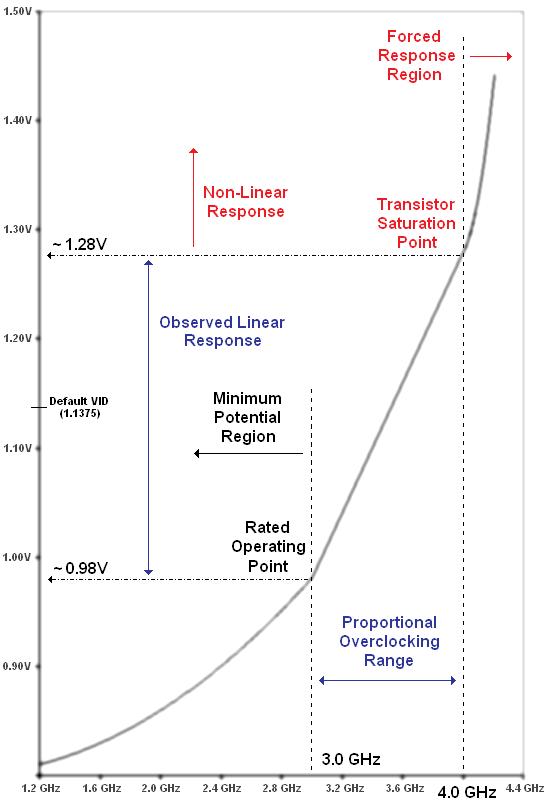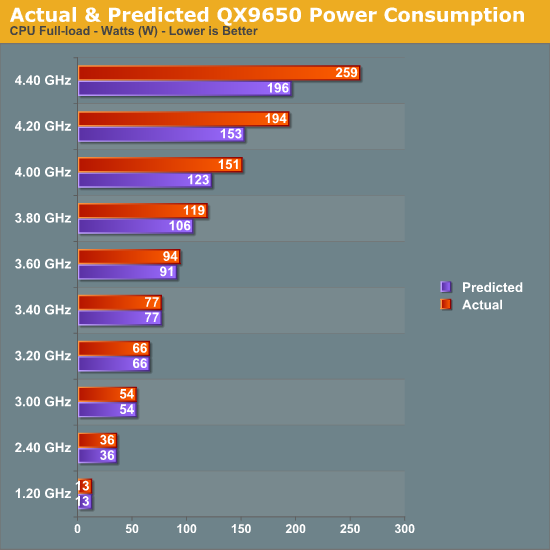Overclocking Intel's New 45nm QX9650: The Rules Have Changed
by Kris Boughton on December 19, 2007 2:00 AM EST- Posted in
- CPUs
Exploring the Limits of 45nm Silicon
During the course of our testing we made a rather interesting discovery regarding 45nm silicon scaling: a window exists in which CPU frequency responds in a highly proportional manner. Calculating this value later tells us that between 3.0GHz and 4.0GHz our processor requires ~0.3mV (0.0003V) more Vcore for each one megahertz increase in core frequency. Since our QX9650 is capable of running the stock 3.0GHz setting at only 0.98V, this means that achieving a stable 3.6GHz overclock requires 0.98V + (0.3mV/MHz)(600MHz) = 1.16V. This general trend continues all the way to about 4.0GHz where we found total stability at an amazingly low 1.28V. We cannot help but feel excited about Intel's new 45nm process, especially considering such early maturity.

Always target the higher end of the Proportional Overclocking Region
Dropping below 3.0GHz allows us a chance to experiment in the world of low-voltage (LV) and ultra low-voltage (ULV) clocking. Two point four gigahertz (2.4GHz) was possible at only 0.90V. Additionally, the lowest possible core speed that we could dial-in using the ASUS P5E3 (6 x 200MHz = 1.20GHz) had no problems maintaining stability at only 0.81V. It's interesting to note that this is also the lowest Vcore we could supply the CPU, as VID settings below 0.85000 were not available for use. As an aside, the VRM 11.0 specification, used extensively by motherboards supporting 65nm CPUs, calls for selection values down to 0.70000V.
As expected, pushing the QX9650 above 4.0GHz, although possible, also demands more Vcore than predicted by our simple scaling equation. In fact, running well in excess of this speed requires a nearly exponential increase in voltage. At this point gains are small and generally not worth the extra heat produced because of the excess power consumed. Clearly, the more efficient silicon switching that comes with better cooling is needed if we planning to go much higher. Oddly enough, for the first time in water-cooled quad-core history, we feel as though heat is not the limiting factor. Rather than push this finding aside, we decided to examine the cause a little more closely.

We start our investigation by comparing our measured processor power consumption values with those found through use of the well-known power scaling equation (shown above). The equation wonderfully predicts what we see at lower frequencies but quickly falls behind actual measured values when looking at higher speeds:

A quick check for clues as to the differences turns up one important oversight. Intel's newest power prediction equation includes an extra factor - processor capacitance. Research indicates that the capacitance associated with the transistors gates has become quite significant; possibly more so with 45nm Hi-k transistors than those made using any other previous process technology. We decided to establish the region boundary in the plot above using the point in which this effect became significant, even though the extra transistor capacitance created at higher switching frequencies begins to manifest itself as additional power required at lower processor speeds (around 3.6GHz). At 4.0GHz this additional factor accounts for 25% more power than would otherwise be predicted.
Although we cannot explain exactly why capacitance becomes such a large factor at higher speeds, average core temperature may be a factor. This would certainly help to explain why microprocessors experience such dramatic increases in switching efficiencies when super cooled. Typically, a processor needs significantly less voltage in order to run equivalent speeds under phase-change or liquid nitrogen than would be required with typical air or water-cooling. In fact, based on what we have seen, these 45nm processors may be the first of many in which overclockers find they reach silicon limits before anything else. In the past, it was comforting to know that a bigger heatsink, more powerful fan, or a better water block held the promise of a higher overclock; with 45nm this may no longer be the case.










56 Comments
View All Comments
Kougar - Thursday, December 20, 2007 - link
This was the exact type of article I love to sit down and read through. It doesn't matter if portions of it are above my head, it just gets me to rise up another level to grab at them. Your article was a great read and I very much hope to see many more like this one in the future!Regarding the P5E3, I am somewhat surprised that 0.81v was the lowest you could set. Even the budget board P31-DS3L offers 0.51v as an option, my personal P35-DQ6 has 0.50v as a vCore option. I found your commentary regarding Load Line Calibration to be illuminating... this is exactly what enthusiasts like myself and others need to know.
Lastly, I hate to ask here but Google was no help, Intel's ARK database didn't cover it, and Intel's datasheet didn't mention that I could see... what exactly is P35's process size and default vCore? The same as X38's...? As much as I love Gigabyte they are notorious for their lack of system voltage info...
kjboughton - Thursday, December 20, 2007 - link
The P35 and X38 chipsets are both made using Intel's standard 90nm process technology. It's not uncommon for chipset's to lag behind current CPU offerings by a whole process generation or more. With that being said, Intel's upcoming P45 chipset, the last of it's kind (recall that all future CPU technologies will make use of an onboard memory controllers) will be made on the 65nm process -- something even the X48 won't have. In fact, this reduction in process size may have considerable benefits for P45 when it comes to the reduction in power consumption and increased performance headroom, particularlly when overclocking. The P45 default Vmch is 1.15V, X38 is slightly higer at 1.25V. Based on this I would expect to see the P45 come in around 1.05V or possibly even lower.myocardia - Thursday, December 20, 2007 - link
Kris, great article. But, when did $400-500 worth of watercooling equipment become so commonplace, as to be putting the one (or is that two?) companies who make phase-change units out of business? If freon is no longer needed for extreme CPU cooling, couldn't Vapochill just start making even more expensive, higher-end watercooling?spamme33 - Thursday, December 20, 2007 - link
I have been overclocking since my first computer build years and years ago, rarely do I learn that much from one article. Very well written, informative, and timely!kilkennycat - Thursday, December 20, 2007 - link
The documentation accompanying the BIOS settings of almost all enthusiast motherboards is frequently obscure and incomplete - probably because it is printed many months before the board/BIOS is released, plus the leading manufacturers never bother to update BIOS user-documentation when they update the BIOS. Also, it does seem that the documentation authors have a uniformly poor grasp of the English language and prefer to keep descriptions of all BIOS settings as vague and incomprehensible as possible. It is also so common to find sundry BIOS entries not documented AT ALL anywhere in the motherboard manual, even the (so-called) latest on-line version.So I have a request on behalf of those like myself desperately trying to understand each entry in the BIOS of that brand-new and very expensive enthusiastic motherboard that I have just purchased, with that abysmal so-called user-manual and pathetic in-BIOS "Help" Function-key :-
Would it be possible for you or other at Anandtech to fully document/explain all the terms used in the text of the CPU and memory BIOS settings of the most popular enthusiast motherboards?
To keep such an exercise manageable, I suggest confining the exercise initially to existing and upcoming enthusiast desktop motherboards that are fully compatible with Penryn and Phenom. At present, X48, nVidia 780i, AMD 790FX.....
poohbear - Thursday, December 20, 2007 - link
thank you very much for such an informative and detailed article. very much appreciated for us overclockers and the future looks fantabulous w/ these cpus.wyemarn - Thursday, December 20, 2007 - link
Thank you very much for this great article. What a wonderful Christmas gift from Anandtech! This is one the most complete article I have ever read. CPU performance, overclocking, mobo settings, power consumption all in one article. What a joy to read.akaevile - Thursday, December 20, 2007 - link
Thank you for the detailed information. One has to be a little nervous however for the implications in what your work has found. Will Intel's improvements in refining 45nm technology push the line or has it been drawn in the sand??n7 - Wednesday, December 19, 2007 - link
Really superb article.Possibly the best i've ever seen on AT!
Thanx for the indepth info!
Bozo Galora - Wednesday, December 19, 2007 - link
looks like not only the X48, but three 45nm quads also will be delayed - due to AMD incompetence.http://www.digitimes.com/mobos/a20071218PD212.html">http://www.digitimes.com/mobos/a20071218PD212.html